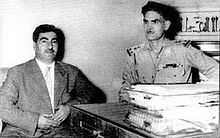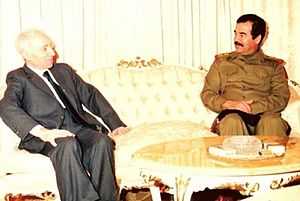Sectarian violence in Iraq
Sectarian violence in Iraq is a recurring issue throughout the history of the region, since the modern borders of Iraq were mostly demarcated in 1920 by the League of Nations. The country, as established, was immediately home to a variety of religious and cultural groups that have clashed as power has ebbed back and forth between them.
Iraqi-Kurdish wars

In 1958, Abdul Karim Qasim took power in Iraq in a military coup. Qasim invited exiled Kurdish leader Barzani to return and promised to give the Kurds regional autonomy in return for Barzani's support for his policies. Barzani became the head of the Kurdistan Democratic Party (KDP), which was granted legal status in 1960. When it became apparent that Qasim would not follow through with his promise of regional autonomy, the KDP began to agitate for regional autonomy. In the face of growing Kurdish dissent, as well as Barzani's personal power, Qasim began to incite the Barzanis historical enemies, the Bradost and Zebari tribes, which led to inter-tribal warfare throughout 1960 and early 1961.
By February 1961, Barzani had and consolidated his position as leader of the Kurds, and ordered his forces to occupy and expel government officials from all Kurdish territory. Qasim began to prepare for a military offensive against the north to return government control of the region. Qasim rejected a detailed ultimatum outlining Kurdish grievances and demanded rectification issued by the KDP in June 1961, and on September 10, an Iraqi army column was ambushed by a group of Kurds, signalling the beginning of a Kurdish revolt. In response to the attack, Qasim ordered the Iraqi Air Force to indiscriminately bomb Kurdish villages, which ultimately served to rally the entire Kurdish population to Barzani's standard. Qasim's profound distrust of the Iraqi Army, which he purposely failed to adequately arm made it impossible to subdue the insurrection, contributing to a Ba'athist coup against Qasim in February 1963.
Under Ba'ath Party rule

The Ba'ath Party dominated Iraq from 1968 unto 2003, with most of this time being under the rule of Saddam Hussein, who came to power in 1979. Under Saddam's rule, most positions of power in Iraq were given to Sunni Muslims, who made up about one fifth of the population. The ongoing fighting between Iraqis and Kurds continued under Ba'ath rule, until after a peace plan was announced in March 1970, providing for broader Kurdish autonomy and Kurdish representation in government bodies, to be implemented in four years.[1] Despite this, the Iraqi government embarked on an Arabization program in the oil rich regions of Kirkuk and Khanaqin in the same period.[2] In the following years, the Iraaqi government overcame its internal divisions and concluded a treaty of friendship with the Soviet Union in April 1972 and ended its isolation within the Arab world. By 1974 the situation in the north escalated again into the Second Kurdish Iraqi War, which lasted until 1975.
When Saddam Hussein came to power, concerns turned to the division between Sunni and Shi'ite factions in Iraq. Ayatollah Ruhollah Khomeini, having been exiled from Iran in 1964, had taken up residence in Iraq, at the Shi'ite holy city of An Najaf. There he involved himself with Iraqi Shi'ites and developed a strong, worldwide religious and political following against the Iranian Government, whom Saddam tolerated. Khomeini began to urge the Shi'ites there to overthrow Saddam, contributing to Saddam's decision to expel Khomeini in 1978 to France. In early 1979, Iran's Shah Mohammad Reza Pahlavi was overthrown by the Islamic Revolution, thus giving way to an Islamic republic led by Khomeini. The influence of revolutionary Shi'ite Islam grew apace in the region, particularly in countries with large Shi'ite populations, especially Iraq. Saddam feared that radical Islamic ideas—hostile to his secular rule—were rapidly spreading inside his country among the majority Shi'ite population. Ultimately, an eight-year-long Iran–Iraq War ensued, ending in a stalemate.
To secure the loyalty of the Shia population during the war, Saddam allowed more Shias into the Ba'ath Party and the government, and improved Shia living standards, which had been lower than those of the Iraqi Sunnis.[3] Saddam had the state pay for restoring Imam Ali's tomb with white marble imported from Italy.[3] The Baathists also increased their policies of repression against the Shia. The most infamous event was the massacre of 148 civilians of the Shia town of Dujail.[4]
Despite the costs of the war, the Iraqi regime made generous contributions to Shia waqf (religious endowments) as part of the price of buying Iraqi Shia support.[5]:75–76 The importance of winning Shia support was such that welfare services in Shia areas were expanded during a time in which the Iraqi regime was pursuing austerity in all other non-military fields.[5]:76 During the first years of the war in the early 1980s, the Iraqi government tried to accommodate the Kurds in order to focus on the war against Iran. In 1983, the Patriotic Union of Kurdistan agreed to cooperate with Baghdad, but the Kurdish Democratic Party (KDP) remained opposed.[6] In 1983, Saddam signed an autonomy agreement with Jalal Talabani of the Patriotic Union of Kurdistan (PUK), though Saddam later reneged on the agreement.[3] By 1985, the PUK and KDP had joined forces, and Iraqi Kurdistan saw widespread guerrilla warfare up to the end of the war.[3]
Towards the end of this war, on 16 March 1988, the Kurdish town of Halabja was attacked with a mix of mustard gas and nerve agents, killing 5,000 civilians, and maiming, disfiguring, or seriously debilitating 10,000 more. (see Halabja poison gas attack)[7] The attack occurred in conjunction with the 1988 al-Anfal Campaign designed to reassert central control of the mostly Kurdish population of areas of northern Iraq and defeat the Kurdish peshmerga rebel forces. The United States now maintains that Saddam ordered the attack to terrorize the Kurdish population in northern Iraq,[7] but Saddam's regime claimed at the time that Iran was responsible for the attack[8] a position which the U.S. supported until several years later.
Following the 2003 invasion of Iraq
Following the 2003 invasion of Iraq, certain elements of the Iraqi insurgency have made a point of targeting Shias in sectarian attacks. In turn, the Sunnis have complained of discrimination and human rights abuses by Iraq's Shia majority government, which is bolstered by the fact that Sunni detainees were allegedly discovered to have been tortured in a compound used by government forces on November 15, 2005.[9] This sectarianism has fueled a giant level of emigration and internal displacement.
Some people advocate an independent nation for the Shias of Iraq. The idea that Iraq could be split into Kurdistan in the north, Iraq in the center and Basra in the south. The thinking is that if each community is busy nation-building, they would not be attacking each other as they would be within a single country where the communities may be striving for political dominance at expense of other communities instead of working together.
Between October 2003 and March 2005 alone, 36% of the 700,000 Iraqis who fled to Syria were Assyrians and other Iraqi Christians, judging from a sample of those registering for asylum on political or religious grounds.[10] Furthermore, the small Mandaean and Yazidi communities are at the risk of elimination due to ethnic cleansing by Islamist extremists.[11][12]
Entire neighborhoods in Baghdad were ethnically cleansed by Shia and Sunni militias and sectarian violence has broken out in every Iraqi city where there is a mixed population.[13] Sunnis have fled Basra, while Shias were driven out of cities and towns north of Baghdad such as Samarra or Baquba.[14][15] Satellite shows ethnic cleansing in Iraq was key factor in "surge" success.[16] Some areas are being evacuated by every member of a particular group due to lack of security, moving into new areas because of fear of reprisal killings.[17][18]
For decades, President Hussein 'Arabised' northern Iraq.[19] Now his ethnic cleansing is being reversed.[20] Thousands of ethnic Kurds pushed into lands formerly held by Iraqi Arabs, forcing at least 100,000 of them to flee to refugee camps.[21] Sunni Arabs have driven out at least 70,000 Kurds from Mosul’s western half.[22] Nowadays, eastern Mosul is Kurdish and western Mosul is Sunni Arab.[23] The policies of Kurdification by KDP and PUK after 2003 (with non-Kurds being pressured to move, in particular Assyrian Christians and Iraqi Turkmen) have prompted serious inter-ethnic problems.[24]
In 2014, a group called the Islamic State of Iraq and the Levant (ISIL) began to overtake much of Northern Iraq. Known for its extreme interpretation of the Islamic faith and sharia law[25] and its brutal violence,[26][25] ISIL has sought to attack Shia Muslims, indigenous Assyrian and Armenian Christians, Yazidis, Druze, Shabaks and Mandeans in particular.[27]
See also
References
- ↑ Harris, G. S. (1977). "Ethnic Conflict and the Kurds". Annals of the American Academy of Political and Social Science 433 (1): 118–120. doi:10.1177/000271627743300111.
- ↑ "Introduction : GENOCIDE IN IRAQ: The Anfal Campaign Against the Kurds (Human Rights Watch Report, 1993)". Hrw.org. Retrieved 2010-12-28.
- ↑ 3.0 3.1 3.2 3.3 Karsh, Efraim (25 April 2002). The Iran–Iraq War: 1980–1988. Osprey Publishing. pp. 1–8, 12–16, 19–82. ISBN 978-1841763712.
- ↑ "The Dujail Massacre". Indian Express. 31 December 2006.
- ↑ 5.0 5.1 Bulloch, John; Morris, Harvey (1989). The Gulf War: Its Origins, History and Consequences (1st published ed.). London: Methuen. ISBN 9780413613707.
- ↑ Katzman, Kenneth (1 October 2010). "The Kurds in Post-Saddam Iraq" (PDF). Congressional Research Service. p. 2. Retrieved 2 August 2011.
- ↑ 7.0 7.1 Saddam's Chemical Weapons Campaign: Halabja, 16 March 1988 — Bureau of Public Affairs
- ↑ Pelletiere, Stephen C. (31 January 2003). "A War Crime or an Act of War?". New York Times.
- ↑ "Iraqi Sunnis demand abuse inquiry". BBC News. November 16, 2005. Retrieved 2007-05-12.
- ↑ Söderlindh, Lisa (2006-05-03). "Assyrians Face Escalating Abuses in "New Iraq"". Inter-Press Service.
- ↑ Crawford, Angus (2007-03-04). "Iraq's Mandaeans 'face extinction'". BBC News.
- ↑ Damon, Arwa; Mohammed Tawfeeq and Raja Razek (2007-08-15). "Iraqi officials: Truck bombings killed at least 500". CNN.
- ↑ Sects slice up Iraq as US troops 'surge' misfires
- ↑ Iraq is disintegrating as ethnic cleansing takes hold
- ↑ "There is ethnic cleansing"
- ↑ Satellite images show ethnic cleanout in Iraq, Reuters, September 19, 2008
- ↑ U.N.: 100,000 Iraq refugees flee monthly. Alexander G. Higgins, Boston Globe, November 3, 2006
- ↑ Iraq refugees chased from home, struggle to cope
- ↑ _Toc78803800 Forced Displacement and Arabization of Northern Iraq
- ↑ Iraq Ethnic Cleansing Archives
- ↑ THE REACH OF WAR: NORTHERN IRAQ; KURDS ADVANCING TO RECLAIM LAND IN NORTHERN IRAQ, New York Times
- ↑ Sunni Arabs driving out Kurds in northern Iraq
- ↑ The other Iraqi civil war, Asia Times
- ↑ Stansfield, Gareth. (2007). Iraq: People, History, Politics. p71
- ↑ 25.0 25.1 Bulos, Nabih (20 June 2014). "Islamic State of Iraq and Syria aims to recruit Westerners with video". Los Angeles Times. Retrieved 23 June 2014.
- ↑ McCoy, Terrence (13 June 2013). "ISIS, beheadings and the success of horrifying violence". The Washington Post. Retrieved 23 June 2014.
- ↑ Abi-Habib, Maria (26 June 2014). "Iraq's Christian Minority Feels Militant Threat". The Wall Street Journal. Retrieved 6 July 2014.(subscription required) Accessible via Google.